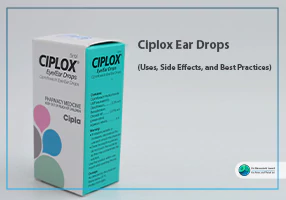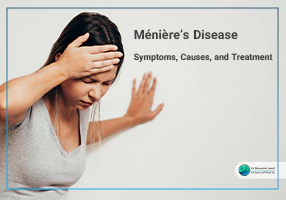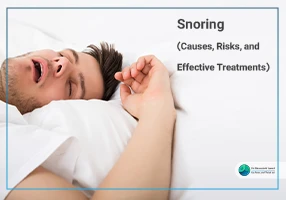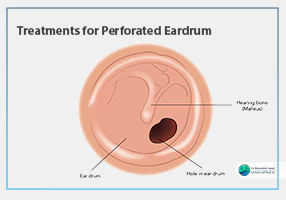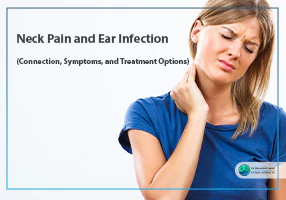Ménière’s Disease: A Comprehensive Guide to Symptoms, Causes, and Treatment
Ménière’s disease is a chronic condition of the inner ear that can significantly impact quality of life, causing unpredictable episodes of vertigo, hearing loss, tinnitus, and a sensation of fullness in the ear. Named after the French physician Prosper Ménière, who first described it in 1861, this condition affects approximately 0.2% of the population, often striking adults between 40 and 60 years old. While it typically involves one ear, about 15% of patients experience symptoms in both ears. This guide aims to provide a thorough understanding of Ménière’s disease, from its symptoms and causes to the latest treatment options, empowering readers with the knowledge to manage or seek professional care for this condition. Whether you’re newly diagnosed, supporting a loved one, or simply curious, this article offers a complete resource to navigate the complexities of Ménière’s disease with confidence.
 Understanding Ménière’s disease is crucial because its symptoms can be debilitating, affecting daily activities like driving, working, or even walking. By exploring its causes, diagnostic methods, and innovative treatments, this guide will equip you with actionable insights to manage symptoms, reduce the frequency of episodes, and improve overall well-being. Written by experts in ear, nose, and throat (ENT) care, this article draws on the latest medical research to ensure accuracy and relevance, making it a one-stop resource for anyone seeking clarity on this condition.
Understanding Ménière’s disease is crucial because its symptoms can be debilitating, affecting daily activities like driving, working, or even walking. By exploring its causes, diagnostic methods, and innovative treatments, this guide will equip you with actionable insights to manage symptoms, reduce the frequency of episodes, and improve overall well-being. Written by experts in ear, nose, and throat (ENT) care, this article draws on the latest medical research to ensure accuracy and relevance, making it a one-stop resource for anyone seeking clarity on this condition.
What Is Ménière’s Disease?
Ménière’s disease is a disorder of the inner ear that disrupts the body’s balance and hearing systems. It is characterized by episodes of vertigo, fluctuating hearing loss, tinnitus (ringing in the ear), and a feeling of pressure or fullness in the affected ear. These symptoms often come in unpredictable attacks, which can last from 20 minutes to several hours, and may vary in intensity and frequency. Over time, the condition can lead to progressive hearing loss, which may become permanent in some cases.
The inner ear houses critical structures, including the cochlea (responsible for hearing) and the vestibular system (responsible for balance). Ménière’s disease is believed to stem from abnormalities in the fluid dynamics of the inner ear, particularly the endolymph, a fluid that helps regulate hearing and balance. While the exact mechanisms are still under study, this condition can profoundly affect physical and emotional health, making early diagnosis and management essential.
Who Is Affected by Ménière’s Disease?
Ménière’s disease most commonly affects adults in their 40s and 50s, though it can occur at any age. It is slightly more prevalent in women than men, and while it usually impacts one ear, bilateral cases (affecting both ears) occur in about 15% of patients. Genetic predisposition, autoimmune factors, and environmental triggers may increase the likelihood of developing the condition. Those with a family history of Ménière’s or related ear disorders may be at higher risk.
Symptoms of Ménière’s Disease
 The hallmark symptoms of Ménière’s disease are episodic, meaning they come and go, often with periods of remission between attacks. Understanding these symptoms is key to recognizing the condition and seeking timely medical intervention.
The hallmark symptoms of Ménière’s disease are episodic, meaning they come and go, often with periods of remission between attacks. Understanding these symptoms is key to recognizing the condition and seeking timely medical intervention.
Vertigo Episodes
Vertigo is the most disruptive symptom of Ménière’s disease, characterized by a spinning sensation that feels as though the environment or the individual is moving. These episodes can last from 20 minutes to several hours (typically less than 24 hours) and may be accompanied by nausea, vomiting, sweating, or diarrhea. Severe vertigo can make it difficult to stand or walk, significantly impacting daily life.
Hearing Loss
Hearing loss in Ménière’s disease is often fluctuating, meaning it may worsen during an attack and improve afterward. In the early stages, hearing loss is temporary, but as the disease progresses, it can become permanent, particularly affecting low-frequency sounds. This progressive hearing loss can make it challenging to follow conversations or hear certain sounds clearly.
Tinnitus
Tinnitus, or ringing in the ear, is another common symptom. Patients may describe hearing sounds like buzzing, hissing, roaring, or whistling in the affected ear. Tinnitus can vary in intensity and may be more noticeable during or between vertigo episodes, contributing to discomfort and distraction.
Aural Fullness
Many individuals with Ménière’s disease report a sensation of pressure or fullness in the affected ear, often likened to the feeling of a blocked ear during a cold. This symptom may precede or accompany vertigo attacks and can add to the overall discomfort.
Additional Symptoms
Beyond the core symptoms, patients may experience:
- Balance Issues: Difficulty maintaining stability, especially between attacks.
- Hyperacusis: Sensitivity to loud sounds, which can exacerbate discomfort.
- Headaches or Migraine-Like Symptoms: Some patients report head pain or visual disturbances.
- Anxiety and Emotional Distress: The unpredictability of attacks can lead to stress or anxiety.
- Cold Sweats and Heart Palpitations: Often triggered by severe vertigo episodes.
These symptoms can mimic other conditions, such as vestibular migraine or labyrinthitis, making accurate diagnosis critical. If symptoms persist beyond 24 hours, they may indicate another underlying issue.
Causes and Risk Factors of Ménière’s Disease
 The precise cause of Ménière’s disease remains unclear, but research points to several contributing factors, primarily related to the inner ear’s fluid dynamics.
The precise cause of Ménière’s disease remains unclear, but research points to several contributing factors, primarily related to the inner ear’s fluid dynamics.
Endolymphatic Hydrops
The leading theory suggests that Ménière’s disease results from an abnormal buildup of endolymph fluid in the inner ear, a condition known as endolymphatic hydrops. This excess fluid disrupts the delicate balance and hearing mechanisms, leading to the characteristic symptoms. The reasons for this fluid buildup are not fully understood but may involve impaired drainage or overproduction of endolymph.
Potential Triggers and Risk Factors
Several factors may contribute to or trigger Ménière’s disease:
- Genetic Predisposition: A family history of Ménière’s or similar ear disorders increases risk.
- Autoimmune Responses: Abnormal immune system activity may attack inner ear structures.
- Viral or Bacterial Infections: Past infections, such as those affecting the inner ear, may play a role.
- Allergies: Allergic reactions could trigger inflammation in the inner ear.
- Head Trauma: Physical injury to the head or ear may disrupt inner ear function.
- Stress and Fatigue: Emotional or physical stress can exacerbate symptoms or trigger episodes.
- Dietary Factors: High salt intake, caffeine, or alcohol consumption may worsen fluid retention in the inner ear.
Environmental and Lifestyle Triggers
Certain lifestyle factors can aggravate Ménière’s symptoms:
- High-Sodium Diets: Excess salt can increase fluid retention, worsening endolymphatic hydrops.
- Caffeine and Alcohol: These substances may affect inner ear fluid dynamics or exacerbate vertigo.
- Smoking: Nicotine and other chemicals in cigarettes may worsen tinnitus and other symptoms.
- Sleep Deprivation: Lack of rest can heighten stress and trigger episodes.
Understanding these triggers can help patients manage their condition through lifestyle adjustments and medical interventions.
Diagnosing Ménière’s Disease
Diagnosing Ménière’s disease requires a comprehensive evaluation by an ENT specialist, as its symptoms overlap with other conditions like vestibular migraine, labyrinthitis, or transient ischemic attacks. A combination of medical history, physical exams, and specialized tests is used to confirm the diagnosis.
Diagnostic Tests
- Audiometry (Hearing Test): Measures hearing loss, particularly in the affected ear, to identify fluctuating or progressive patterns.
- Electronystagmography (ENG): Assesses eye movements in response to warm or cool air in the ear canal to evaluate balance function.
- Electrocochleography (ECoG): Measures electrical activity in the cochlea to detect abnormal fluid pressure.
- Vestibular Evoked Myogenic Potential (VEMP): Tests the inner ear’s response to loud sounds to assess vestibular function.
- Rotary Chair Test: Evaluates balance by measuring responses to controlled chair movements.
- Video Head Impulse Test (vHIT): Uses video to analyze eye movements during rapid head turns.
- Auditory Brainstem Response (ABR): Measures brain activity in response to sounds, often used when other tests are not feasible.
- Posturography: Assesses balance by measuring stability on a moving platform.
- Imaging (MRI/CT): Rules out other causes, such as brain tumors or multiple sclerosis, that may mimic Ménière’s symptoms.
A diagnosis is typically confirmed if a patient has at least two episodes of vertigo lasting 20 minutes to 12 hours, documented hearing loss, and tinnitus or aural fullness in the affected ear.
Treatment Options for Ménière’s Disease
 While there is no definitive cure for Ménière’s disease, a range of treatments can manage symptoms, reduce the frequency of attacks, and improve quality of life. Treatment plans are tailored to the individual, depending on symptom severity and response to therapy.
While there is no definitive cure for Ménière’s disease, a range of treatments can manage symptoms, reduce the frequency of attacks, and improve quality of life. Treatment plans are tailored to the individual, depending on symptom severity and response to therapy.
Lifestyle Modifications
Lifestyle changes are often the first line of defense:
- Low-Sodium Diet: Reducing salt intake helps minimize fluid retention in the inner ear. Aim for less than 2,000 mg of sodium daily.
- Hydration: Drinking 6–8 glasses of water daily supports fluid balance.
- Avoiding Triggers: Limit caffeine, alcohol, chocolate, and monosodium glutamate (MSG).
- Stress Management: Practices like yoga, meditation, or mindfulness can reduce stress-induced episodes.
- Quitting Smoking: Eliminating tobacco use may alleviate tinnitus and improve overall ear health.
- Rest During Attacks: Lying down in a quiet, dark room during vertigo episodes can minimize discomfort.
Medications
Medications target specific symptoms:
- Anti-Vertigo Drugs: Meclizine (Antivert), diazepam (Valium), or scopolamine reduce vertigo and nausea.
- Anti-Nausea Medications: Prochlorperazine (Compazine) helps control vomiting during attacks.
- Diuretics: Triamterene/hydrochlorothiazide (Dyazide, Maxzide) reduce fluid buildup in the inner ear.
- Steroids: Oral or injected corticosteroids, like dexamethasone, reduce inflammation and vertigo.
Middle Ear Injections
For severe vertigo, doctors may inject medications directly into the middle ear:
- Gentamicin: An antibiotic that reduces vestibular function to control vertigo. It carries a risk of hearing loss and requires careful administration.
- Steroids (Dexamethasone): Less invasive than gentamicin, steroids reduce inflammation and vertigo with a lower risk to hearing.
Surgical Interventions
Surgery is considered when other treatments fail or symptoms are severe:
- Endolymphatic Sac Decompression: Removes a small portion of bone around the endolymphatic sac to reduce fluid pressure. This is a less invasive option with a lower risk of hearing loss.
- Labyrinthectomy: Removes part of the inner ear to eliminate vertigo but often results in complete hearing loss in the affected ear. It is reserved for severe cases.
- Vestibular Nerve Section: Cuts the vestibular nerve to stop vertigo signals to the brain. This procedure preserves hearing in most cases but is complex and carries risks.
Vestibular Rehabilitation Therapy (VRT)
VRT involves exercises guided by a physical therapist to improve balance and reduce dizziness. These exercises help the brain adapt to inner ear changes, enhancing stability between attacks.
Hearing Aids and Tinnitus Management
- Hearing Aids: Amplify sound to compensate for hearing loss, improving communication.
- Tinnitus Maskers: Devices that produce white noise or soothing sounds to distract from tinnitus.
- Combined Devices: Some hearing aids include tinnitus-masking features for dual benefits.
Emerging Treatments
Recent advancements in Ménière’s disease management include:
- Positive Pressure Therapy: Devices like the Meniett deliver low-pressure pulses to the middle ear to reduce fluid buildup. Studies show mixed results, but it’s a non-invasive option for some patients.
- Cochlear Implants: For those with significant hearing loss, cochlear implants may restore auditory function in severe cases.
- Gene Therapy and Regenerative Medicine: Early research explores targeting genetic or cellular factors to restore inner ear function, though these are not yet widely available.
Living with Ménière’s Disease
Managing Ménière’s disease extends beyond medical treatments. Patients can take proactive steps to cope with the condition:
- Support Groups: Connecting with others through organizations like the Ménière’s Society provides emotional support and practical tips.
- Mental Health Care: Counseling or therapy can address anxiety or depression caused by unpredictable symptoms.
- Safety Precautions: Avoid activities like driving or climbing during vertigo-prone periods to prevent injury.
When to See an ENT Specialist
 If you experience recurrent vertigo, hearing loss, tinnitus, or ear fullness, consult an ENT specialist promptly. Early diagnosis can prevent complications and improve treatment outcomes. For expert care, contact a board-certified ENT specialist, such as Dr. Masoumeh Saeedi, a renowned otolaryngologist and skull base surgeon, at [your website link].
If you experience recurrent vertigo, hearing loss, tinnitus, or ear fullness, consult an ENT specialist promptly. Early diagnosis can prevent complications and improve treatment outcomes. For expert care, contact a board-certified ENT specialist, such as Dr. Masoumeh Saeedi, a renowned otolaryngologist and skull base surgeon, at [your website link].
Conclusion
Ménière’s disease is a complex condition that requires a multifaceted approach to manage effectively. By understanding its symptoms, causes, and treatment options, patients can take control of their health and minimize its impact on daily life. From lifestyle adjustments and medications to advanced surgical options, there are numerous ways to address this condition. If you suspect Ménière’s disease, seek professional evaluation to begin your journey toward relief.
Meta Description: Discover everything you need to know about Ménière’s disease, including symptoms, causes, and the latest treatments. This comprehensive guide offers expert insights to manage vertigo, hearing loss, and tinnitus effectively.
Related Articles
Online Consultation, Directly with Dr. Saeedi
Ask your question via WhatsApp, and if you wish, Send your photo for a more accurate assessment.
Free Consultation on WhatsApp

